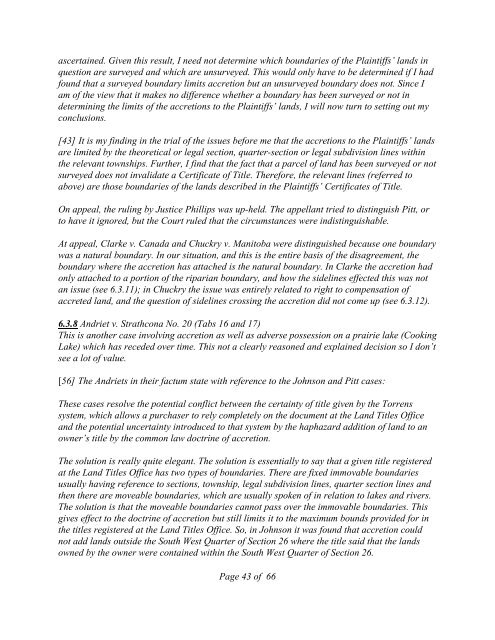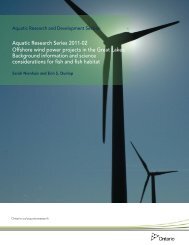Report of Research, Field Investigation and Survey of Robert D ...
Report of Research, Field Investigation and Survey of Robert D ...
Report of Research, Field Investigation and Survey of Robert D ...
Create successful ePaper yourself
Turn your PDF publications into a flip-book with our unique Google optimized e-Paper software.
ascertained. Given this result, I need not determine which boundaries <strong>of</strong> the Plaintiffs’ l<strong>and</strong>s in<br />
question are surveyed <strong>and</strong> which are unsurveyed. This would only have to be determined if I had<br />
found that a surveyed boundary limits accretion but an unsurveyed boundary does not. Since I<br />
am <strong>of</strong> the view that it makes no difference whether a boundary has been surveyed or not in<br />
determining the limits <strong>of</strong> the accretions to the Plaintiffs’ l<strong>and</strong>s, I will now turn to setting out my<br />
conclusions.<br />
[43] It is my finding in the trial <strong>of</strong> the issues before me that the accretions to the Plaintiffs’ l<strong>and</strong>s<br />
are limited by the theoretical or legal section, quarter-section or legal subdivision lines within<br />
the relevant townships. Further, I find that the fact that a parcel <strong>of</strong> l<strong>and</strong> has been surveyed or not<br />
surveyed does not invalidate a Certificate <strong>of</strong> Title. Therefore, the relevant lines (referred to<br />
above) are those boundaries <strong>of</strong> the l<strong>and</strong>s described in the Plaintiffs’ Certificates <strong>of</strong> Title.<br />
On appeal, the ruling by Justice Phillips was up-held. The appellant tried to distinguish Pitt, or<br />
to have it ignored, but the Court ruled that the circumstances were indistinguishable.<br />
At appeal, Clarke v. Canada <strong>and</strong> Chuckry v. Manitoba were distinguished because one boundary<br />
was a natural boundary. In our situation, <strong>and</strong> this is the entire basis <strong>of</strong> the disagreement, the<br />
boundary where the accretion has attached is the natural boundary. In Clarke the accretion had<br />
only attached to a portion <strong>of</strong> the riparian boundary, <strong>and</strong> how the sidelines effected this was not<br />
an issue (see 6.3.11); in Chuckry the issue was entirely related to right to compensation <strong>of</strong><br />
accreted l<strong>and</strong>, <strong>and</strong> the question <strong>of</strong> sidelines crossing the accretion did not come up (see 6.3.12).<br />
6.3.8 Andriet v. Strathcona No. 20 (Tabs 16 <strong>and</strong> 17)<br />
This is another case involving accretion as well as adverse possession on a prairie lake (Cooking<br />
Lake) which has receded over time. This not a clearly reasoned <strong>and</strong> explained decision so I don’t<br />
see a lot <strong>of</strong> value.<br />
[56] The Andriets in their factum state with reference to the Johnson <strong>and</strong> Pitt cases:<br />
These cases resolve the potential conflict between the certainty <strong>of</strong> title given by the Torrens<br />
system, which allows a purchaser to rely completely on the document at the L<strong>and</strong> Titles Office<br />
<strong>and</strong> the potential uncertainty introduced to that system by the haphazard addition <strong>of</strong> l<strong>and</strong> to an<br />
owner’s title by the common law doctrine <strong>of</strong> accretion.<br />
The solution is really quite elegant. The solution is essentially to say that a given title registered<br />
at the L<strong>and</strong> Titles Office has two types <strong>of</strong> boundaries. There are fixed immovable boundaries<br />
usually having reference to sections, township, legal subdivision lines, quarter section lines <strong>and</strong><br />
then there are moveable boundaries, which are usually spoken <strong>of</strong> in relation to lakes <strong>and</strong> rivers.<br />
The solution is that the moveable boundaries cannot pass over the immovable boundaries. This<br />
gives effect to the doctrine <strong>of</strong> accretion but still limits it to the maximum bounds provided for in<br />
the titles registered at the L<strong>and</strong> Titles Office. So, in Johnson it was found that accretion could<br />
not add l<strong>and</strong>s outside the South West Quarter <strong>of</strong> Section 26 where the title said that the l<strong>and</strong>s<br />
owned by the owner were contained within the South West Quarter <strong>of</strong> Section 26.<br />
Page 43 <strong>of</strong> 66
















